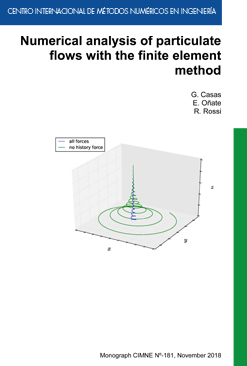Numerical analysis of particulate flows with the finite element method
FREE!
In this work we study the numerical simulation of particle-laden fluids, with an emphasis on
Newtonian fluids and spherical, rigid particles.
Our general strategy consists in using the discrete element method (DEM) to model the
particles and the finite element method (FEM) to discretize the continuous phase, such that the fluid is not resolved around the particles, but rather averaged over them. The effect of the particles on the fluid is taken into account by averaging (filtering) their individual volumes and particle-fluid interaction forces.
In the first part of the work we study the Maxey–Riley equation of motion for an isolated
particle in a nonuniform flow; the equation used to calculate the trajectory of the DEM
particles. In particular, we perform a detailed theoretical study of its range of applicability,
reviewing the initial effects of breaking its fundamental hypotheses, such as small Reynolds
number, sphericity of the particle, isolation etc. The output of this study is a set of tables
containing order-of-magnitude inequalities to assess the validity of the method in practice.
The second part of the work deals with the numerical discretization of the MRE and, in
particular, the study of different techniques for the treatment of the history-dependent term,
which is difficult to calculate efficiently. We provide improvements on an existing method,
proposed by van Hinsberg et al. (2011), and demonstrate its accuracy and efficiency in a
sequence of tests of increasing complexity.
In the final part of the work we give three application examples representative of different
regimes that may be encountered in the industry, demonstrating the versatility of our numerical tool. For that, we describe necessary generalizations to the MRE to cover problems outside its range of applicability. Furthermore, we give a detailed account of the stabilized FEM algorithm used to discretize the fluid phase and compare several derivative recovery tools necessary to calculate some of the interphase coupling terms. Finally, we generalize the algorithm to include the backward-coupling effects according to the theory of multicomponent continua, allowing the code to deal with arbitrarily dense flow regimes.

